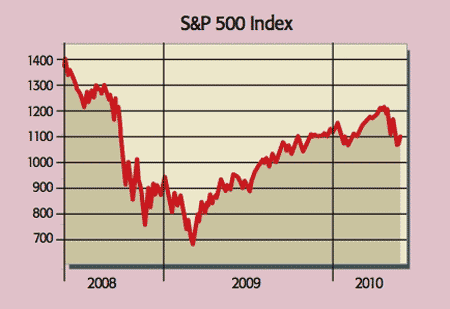
Last week global stockmarkets shrugged off their panic over European sovereign debt and concentrated on the fact that “the global expansion is moving forward”, says Nariman Bahravesh of IHS Global Insight. But early this week jitters returned, as it appeared to be dawning on more and more investors that the global expansion looks set to stop moving forward – and could well move backwards.
For starters, factory production growth in China, South Korea, and Taiwan slowed last month as orders declined, suggesting that global demand is easing. As for Europe’s fiscal crisis, the “recovery will suffer and the collapsing euro will subtract from growth in its key trading partners”, says Nouriel Roubini of New York University, who predicted the financial crisis. That’s a best-case scenario, he reckons.
The worst case, as we detailed last week, is that “a wave of disorderly defaults could unhinge the financial system”. With concern over defaults in the periphery set to endure, interbank rates – and hence banks’ funding costs and the cost of credit – look likely to stay high.
In America, the government’s request to Congress for a fresh fiscal boost looks like “a tacit admission that the economy is already losing thrust” as stimulus from the original package fades, says Ambrose Evans-Pritchard in The Daily Telegraph. The leading indicators are rolling over, lending continues to fall and the renewed crisis in the housing market (see right) is not only more bad news for banks, but also bodes ill for consumer confidence and consumption.
Throw in the worsening fiscal squeeze across the West and it’s easy to see why global growth is set to disappoint or double dip. But equity markets still seem to be expecting a V-shaped bounce. Consensus expectations for both the MSCI Developed World index and America’s S&P 500 are for around 60% earnings growth between 2009 and 2011. “This looks way too high” even without a double dip, says a Charles Stanley note.
S&P earnings are expected to reach a new peak next year. So there is plenty of scope for nasty surprises – especially since the S&P 500, which sets the tone for world markets, is still historically expensive. Roubini sees a risk of the index sliding by 20% as the global macroeconomic backdrop deteriorates.